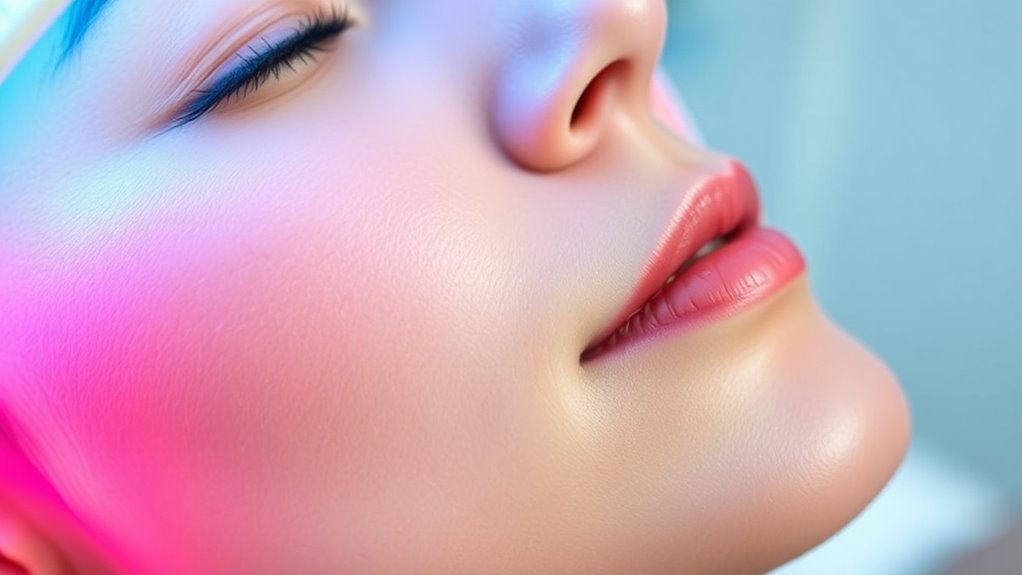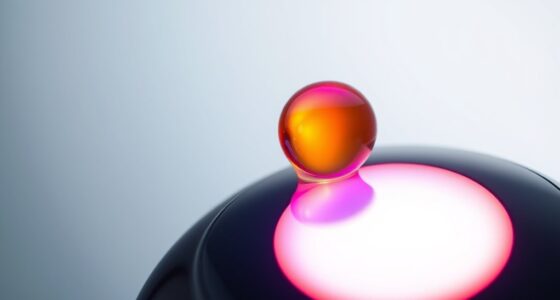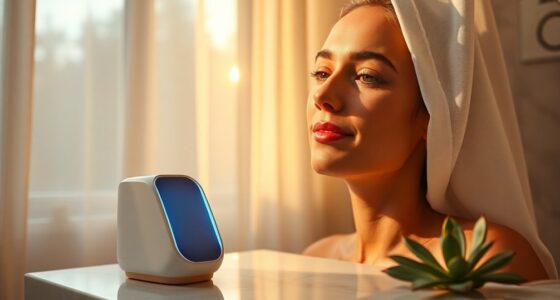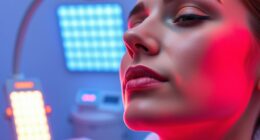To reduce irritation with light therapy on sensitive skin, choose gentle, skin-specific devices designed for delicate skin types. Start with the lowest setting and gradually increase as your skin adapts. Always cleanse your skin beforehand and avoid harsh products that can increase photosensitivity. Use protective goggles and keep treatments short, monitoring how your skin responds. For further tips on making light therapy safer and more effective, there’s more you’ll want to explore.
Key Takeaways
- Choose light therapy devices specifically designed for sensitive skin and start with the lowest intensity setting.
- Always cleanse your skin thoroughly before treatment and avoid harsh skincare products that increase photosensitivity.
- Use protective goggles and keep sessions brief initially, gradually increasing duration as your skin tolerates.
- Monitor your skin’s reaction closely and discontinue treatments if redness, irritation, or discomfort occurs.
- Consult a dermatologist or skincare professional for personalized advice and to ensure safe device selection.

If you have sensitive skin, you might wonder if light therapy is safe for you. It’s natural to worry about how your skin will react, especially since skin sensitivity can make even minor irritations feel overwhelming. The good news is that light therapy can be safe when approached correctly, but understanding the nuances of skin sensitivity and light therapy safety is essential. Your skin’s response depends on its unique sensitivity level, so knowing what to expect can help you minimize irritation and maximize benefits.
Light therapy devices emit specific wavelengths of light that target skin issues like acne, inflammation, or signs of aging. For sensitive skin, it’s crucial to select devices that are gentle and specifically designed for delicate skin types. Always start with the lowest setting and gradually increase intensity as your skin adapts. Remember, just because a device is marketed as safe doesn’t mean it’s automatically suitable for sensitive skin. Checking the product’s specifications and reviews from other users with similar skin concerns can help you choose the right option.
Choose gentle, skin-specific devices and start with low settings for safe light therapy.
When considering light therapy safety, it’s vital to prepare your skin properly. Cleanse your face thoroughly to remove dirt, oil, and makeup, which can exacerbate irritation. Avoid applying harsh skincare products before treatment—especially those containing retinoids, acids, or fragrances—as they can increase photosensitivity and make your skin more prone to irritation. Protecting your eyes with proper goggles is also essential, as some devices emit intense light that can cause discomfort or damage if not used correctly.
Timing your sessions carefully can also reduce skin sensitivity issues. Start with shorter treatments—maybe just a few minutes—and observe how your skin responds. If you notice redness, dryness, or discomfort, pause treatments and allow your skin to recover. Consistency, rather than intensity, is key; regular, gentle sessions can deliver results without overwhelming sensitive skin. Always follow the manufacturer’s instructions, and if you’re unsure, consult a dermatologist familiar with light therapy and skin sensitivity.
Lastly, listen to your skin’s signals. If irritation persists or worsens, discontinue use and seek professional advice. While light therapy can be safe and effective, it’s not a one-size-fits-all solution, especially for sensitive skin. Taking cautious, informed steps ensures you enjoy the benefits without compromising your skin’s health. Remember, patience and proper care are your best tools to safely incorporate light therapy into your skincare routine.
Frequently Asked Questions
Can Light Therapy Worsen Existing Skin Conditions?
Light therapy can worsen existing skin conditions if you have skin sensitivity or allergy risks. It may cause increased irritation, redness, or inflammation, especially if your skin reacts poorly to certain wavelengths or intensities. To protect yourself, consult a dermatologist before starting treatment, and always do a patch test first. Monitoring your skin’s response is key; if you notice worsening symptoms, stop immediately and seek professional advice.
What Ingredients Should I Avoid in Skincare Before Light Therapy?
You should avoid ingredients like retinoids, alpha hydroxy acids, and vitamin C before light therapy, as they can increase skin sensitivity and irritation. These ingredients are some of the key skincare precautions you need to take to prevent adverse reactions. Always patch-test new products and consult your dermatologist if you’re unsure about specific ingredients. By steering clear of these, you reduce the risk of irritation and make certain your light therapy session is safe and effective.
How Long Should I Wait Between Light Therapy Sessions?
A stitch in time saves nine, so proper timing intervals are key. You should wait at least 24 to 48 hours between light therapy sessions, depending on your skin’s sensitivity. This allows your skin to recover and reduces irritation risk. Keep session frequency consistent, usually 2-3 times per week, but always follow your practitioner’s advice. Listening to your skin’s response helps you optimize results while minimizing discomfort.
Are There Specific Light Wavelengths Safer for Sensitive Skin?
Yes, certain wavelengths are generally safer for sensitive skin. You should focus on wavelength selection that minimizes skin irritation, such as red and near-infrared light, which are gentler and less likely to cause redness. Always start with shorter exposure times and lower intensities, and observe how your skin reacts. Consulting with a dermatologist can help you identify the most suitable wavelengths and guarantee your light therapy sessions are safe and effective for your skin sensitivity.
Can I Use Makeup or Skincare Products During Light Therapy?
Yes, you can use makeup or skincare products during light therapy, but choose those that are skincare compatible and free from irritating ingredients. Apply makeup carefully, avoiding areas directly exposed to light therapy, and wait until your session is over before reapplying. Always opt for gentle, non-comedogenic products to minimize irritation, especially if you have sensitive skin. Consult your dermatologist for personalized advice tailored to your skin’s needs.
Conclusion
To protect your delicate skin, think of light therapy as a gentle dance rather than a harsh storm. Use soothing routines and listen to your skin’s whispers, not its screams. With patience and care, you’ll turn irritation into a distant memory, revealing a calmer, brighter glow beneath the surface. Remember, your skin’s comfort is the key to releasing the true potential of light therapy—treat it like a treasured garden, tender and cherished.








